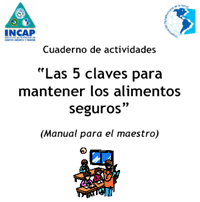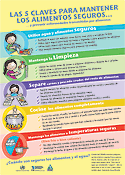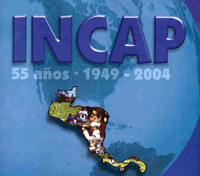Activity Book, The 5 key ways to keep your food safe (Teacher's Manual)
(OPS/INCAP - Institute of Nutrition of Central America and Panama; Guatemala, 2006)

Full Text (in Spanish, 66 pp, PDF, 677 Kb)
Introduction (text to the right)
Introduction: What are germs?
Activity No. 1: How do germs multiply?
Activity No. 2: What do we do that spreads germs?
Way 1: Use safe water and safe food
Activity No. 3: Where do you get safe water?
Activity No. 4: Alphabet soup: The importance of safe water
Activity No. 5: Installing a SODIS system in my school
Way 2: Keep things clean
Activity No. 5: Look at how many germs you can have on your hands!
Activity No. 6: A day in the life of my hands
Activity No. 7: Wash your hands with soap and water
Activity No. 8: What should I do when I am preparing food?
Way 3: Keep raw food separate from cooked food
Activity No. 9: What is cross-contamination?
Activity No. 10: Let's keep cross-contamination from happening!
Way 4: Cook food thoroughly
Activity No. 11: How do we know when food is thoroughly cooked?
Activity No. 12: Celebrating Independence Day in my school
Activity No. 13: Answer and win!!
Way 5: Keep foods VERY hot or VERY cold
Activity No. 14: Where should we keep our food?
Activity No. 15: Boiled milk is safe milk
Activity No. 16: Making balls of yeast rise
Evaluation
Activity No. 17: How do we keep from getting sick to our stomach?
Activity No. 18: The 5 ways to keep your food safe
Activity No. 19: Identifying germs
Activity No. 20: Boys and girls as health inspectors
Answer sheet: Worksheets
Literature citations
5 Key Ways Project: About the Project |
Content Manual |
Manual for the Parent Advisory Council |
Progress Report |
Poster (in Spanish) |
INCAP Project Fact Sheet (in Spanish)

PAHO Links: Food Safety Page
- Institute of Nutrition of Central America and Panama (INCAP)
- Caribbean Food & Nutrition Institute (CFNI)
- Environmental Health & Sustainable Development
Panalimentos
(Pan American food safety center in Argentina)
WHO Links:
- Food Safety
- School Health Promotion
- Global School Health Initiative
- Environmental Health

Introduction
The Teacher's Guide on The 5 key ways to keep your food safe is a facilitating tool for teaching the content contained in the Manual on The 5 key ways to keep your food safe to elementary-school boys and girls.
This educational package is a product of the PAHO-coordinated Project to Adapt and Validate the Manual on the 5 key ways to keep your food safe in elementary schools in Guatemala and Honduras. The project is part of the global Healthy Schools Initiative promoted by PAHO, WHO, and the Institute of Nutrition of Central America and Panama (INCAP).
The objective of this Manual is to provide materials to help teachers so that they in turn can help pupils learn the 5 key ways to keep your food safe in a more entertaining and dynamic way. It is a guide that enables participatory learning such that students can incorporate this knowledge into their daily life, bringing about changes in their behavior and that of their family in a way that will improve their health and well-being.
The Manual includes a set of activities with worksheets aimed at two specific grade-school groups: first- to third-graders, and fourth- to sixth-graders. Each activity is targeted at attaining a specific objective and includes a schema for a preliminary session that teachers can hold with their students to teach them what they need to know before starting the activity. Furthermore, it presents the materials and method to be used when carrying out the activity as well as a series of questions to discuss at the end of each activity, to give the boys and girls a chance to think about what they have just learned.
The activities are guided in such a way that the boys and girls will be putting what they have learned into practice, assessing it, strengthening their knowledge, and visualizing the different concepts by way of demonstrations or experiments.
Teachers can choose from among the suggested activities those they feel to be most appropriate to their local reality, or they can adapt them as they see fit, in accordance with pupils' level of knowledge or skill, the resources available to them, and needs that the teachers sees within the classroom.
We hope this turns out to be useful for you and helps you teach these skills really effectively!!
